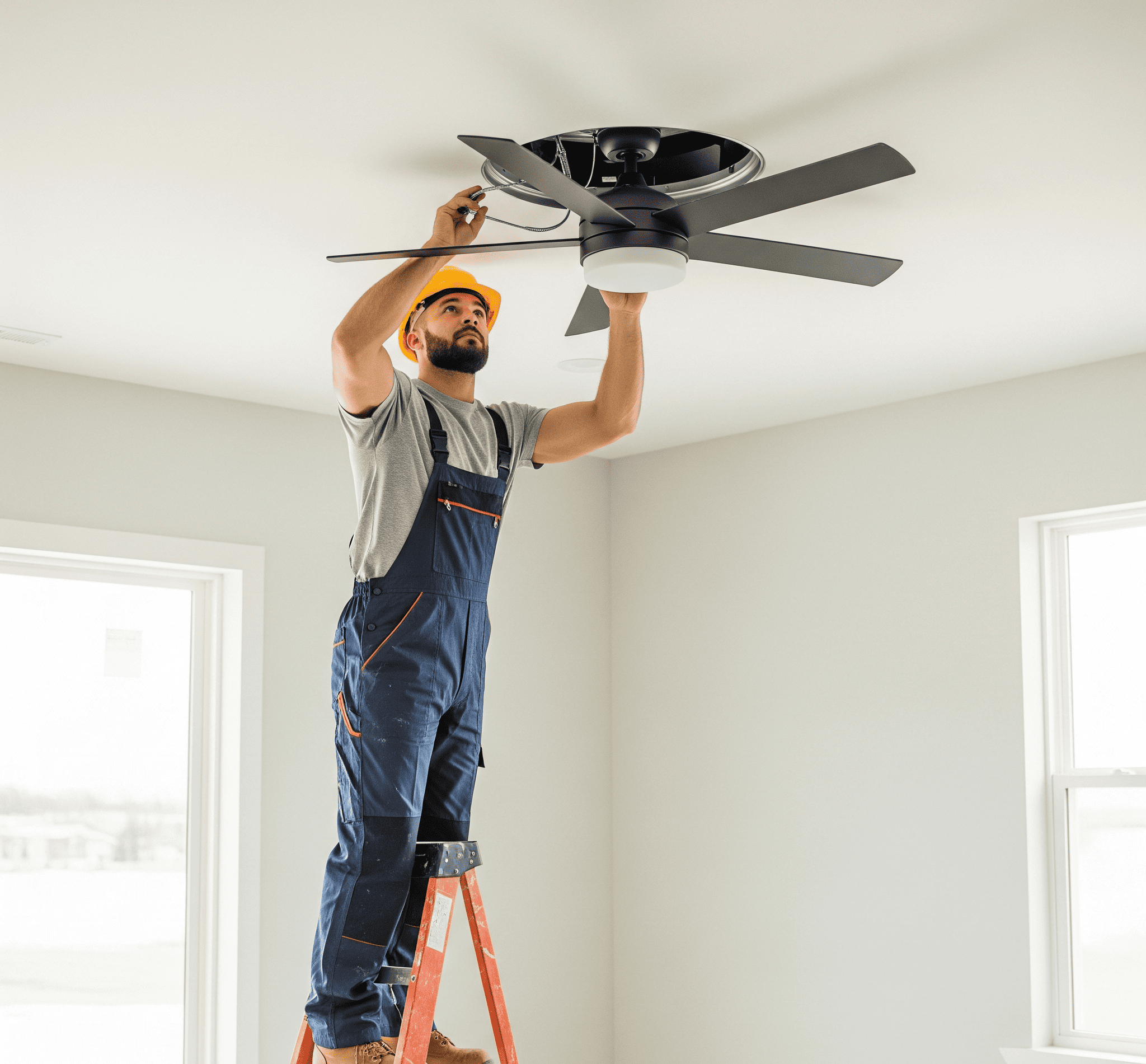Kingsgrove Branch:
How Much Power Does a Ceiling Fan Use

How much power does a ceiling fan use? This isn't just a matter of curiosity; understanding a ceiling fan's energy consumption can significantly impact your electricity bill and your environmental footprint. From the humble attic fan to the high-tech models, various factors affect how much power they draw. We'll dive into the specifics, exploring fan types, motor efficiency, and even how your room's size influences the amount of energy a fan consumes
Get ready to illuminate your understanding of these home essentials
This exploration will cover everything from calculating your fan's power usage to discovering energy-efficient designs. We'll break down the science behind it all in a straightforward and engaging way. Imagine making informed choices about your home's energy use—this guide will empower you to do just that
Understanding Ceiling Fan Power Consumption: How Much Power Does A Ceiling Fan Use
Ceiling fans, a common sight in homes, play a vital role in cooling and comfort. However, their power consumption can affect your energy bills. This article delves into the factors influencing a ceiling fan's energy use, how to calculate its impact, and ways to make your fans more energy-efficient
Defining Ceiling Fan Power Consumption
Ceiling fan power consumption refers to the amount of electrical energy a fan uses to operate. It's typically measured in watts (W) and directly impacts your energy bill. Understanding this consumption helps you make informed decisions about energy use and potentially save money
Factors Affecting Ceiling Fan Energy Use
- Fan Size: Larger fans generally use more power, needing more energy to move air over a larger area
- Motor Efficiency: More efficient motors use less power to achieve the same cooling effect. Modern DC motors often have better efficiency than older AC motors
- Blade Design and Material: Blade shape and material affect air movement and thus the power required to achieve the desired airflow. More aerodynamic designs use less power
- Speed Settings: Higher fan speeds demand more power to spin the blades faster and push more air. Variable speed fans offer greater control and energy savings
Different Fan Types and Their Power Consumption
| Fan Type | Typical Power Consumption (Watts) | Average Usage Time |
| Standard AC Motor, 52" | 120-150 | 4-6 hours |
| DC Motor, 52" | 80-120 | 4-6 hours |
| High-Efficiency DC Motor, 52" | 60-80 | 4-6 hours |
Calculating Power Usage
Estimating power consumption is straightforward. Multiply the fan's wattage by the hours of use. For example, a 100-watt fan used for 5 hours consumes 500 watt-hours (Wh). To calculate cost, multiply this by your electricity rate per kilowatt-hour (kWh)
- Electricity Rates: Local electricity rates determine the cost per kWh. Knowing this rate is crucial for calculating your fan's energy cost
- Kilowatt-Hours (kWh): This is a common unit for measuring electricity consumption. It's simply 1000 watt-hours
Energy Efficiency Considerations
- Energy-Efficient Designs: Look for fans with high energy efficiency ratings, such as Energy Star certified models. They are designed to use less power for the same output
- Variable-Speed Fans: These fans offer multiple speed settings, allowing you to adjust the airflow and power consumption to your needs
- Motor Types: DC motors are generally more efficient than AC motors. They often use less power for the same speed
Practical Applications and Examples
The power consumption of a ceiling fan can vary based on the room size and usage. A fan in a large living room will likely consume more power than a fan in a smaller bedroom
| Room Type | Recommended Fan Size (sq ft) | Estimated Power Consumption (Watts) |
| Living Room (200 sq ft) | 48" | 100-120 |
| Bedroom (120 sq ft) | 40" | 80-100 |
Content Restrictions, How much power does a ceiling fan use
This article aims to provide a clear and concise overview of ceiling fan power consumption, avoiding unnecessary jargon or overly complex explanations. By focusing on key concepts and avoiding lengthy details, it ensures easy understanding for a wide audience
Conclusive Thoughts
So, there you have it—a comprehensive look at how much power a ceiling fan uses. We've covered the factors influencing energy consumption, from the size of the blades to the type of motor. Armed with this knowledge, you can make smart decisions about your home's energy use. Understanding the impact of your ceiling fan's power consumption is key to making informed choices about energy efficiency and saving money on your utility bills
Ever wondered how much juice a ceiling fan sips? Well, it depends! Different fans have different power needs, and learning how to install a ceiling fan can actually help you figure out how much energy it's using. A poorly installed fan, with loose connections or improper mounting, could be a real energy hog
So, get your installation right and you'll save energy and money, and ensure your fan operates at peak efficiency
Remember, small changes can make a big difference
Questions and Answers
How do I calculate the energy cost of a ceiling fan?
Multiply the fan's wattage by the number of hours it runs each month, then multiply that result by your electricity rate per kilowatt-hour
Ever wondered how much juice your ceiling fan sips? Well, it usually depends on the type of fan, like a DC ceiling fan, which, as you'll see in this helpful article how much to install ceiling fan, often uses less energy than a standard AC model. So, if you're looking to save a buck or two, a DC fan could be your answer to a lower energy bill
Basically, energy use varies a lot, but generally, a DC ceiling fan is a smart choice for energy-conscious homeowners
What are the main factors affecting a ceiling fan's power consumption?
Fan size, motor type (AC or DC), blade material and design, and speed settings all influence a ceiling fan's energy use
Are there energy-efficient ceiling fans available?
Yes, many energy-efficient models are available, often featuring features like variable speed controls and high-efficiency motors. Look for Energy Star ratings
How does the room size affect ceiling fan power consumption? Larger rooms generally require larger fans with higher wattage, but the specific needs depend on the room's layout and desired airflow
Recent posts

Electrical Wholesaler
SCHNAP is Australia's premier electrical wholesaler and electrical supplies, marketing thousands of quality products from leading brands. Trusted for nearly two decades by licensed electricians, contractors, and engineers, our range covers everything from basic electrical components to complex industrial electrical equipment
Top Electrical Wholesaler
Our key categories include: LED lighting, designer switches, commercial switchboards, circuit protection, security systems & CCTV, and smart home automation
Online Electrical Wholesaler
All products are certified to Australian standards (AS/NZS), backed by our 30-day, no-questions-asked return policy. Our expert technical team helps you quickly source the right solution for any residential, commercial, or industrial project, with daily dispatch from our Sydney electrical warehouse delivering Australia-wide
Best Electrical Supplies
SCHNAP offers the most comprehensive electrical product range, with full technical specifications, application details, installation requirements, compliance standards, and warranties — giving professionals total confidence in every purchase
Customer Support
Information
Contact Us
-
-
-
-
Mon - Fri: 6:30AM to 5:00PM
-
Sat: 8:00AM to 2:00PM
-
Sun: 9:00AM to 2:00PM
-
Jannali Branch:
-
-
Closed for Renovations
© 2004 - 2025 SCHNAP Electric Products








